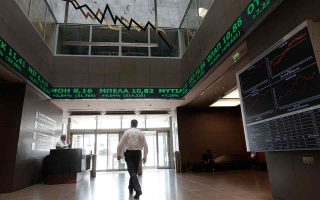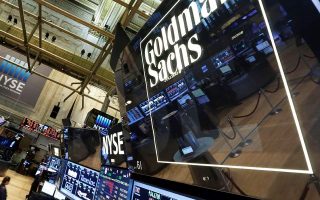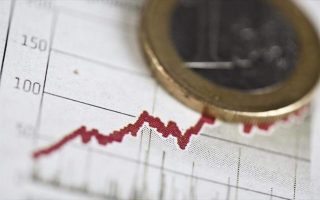Pimco sees seven macro themes for global economy

Investment management giant Pimco identifies seven major macro themes for the global economy in 2020, and projects the slowdown in the eurozone to continue at the same time as Greece expects to start a period of robust growth. While the prospect of a global recession has eased for now, when it does come it may be more difficult to tackle, Pimco argues in a report shared with Kathimerini.
“The outlook for the global economy has improved over the past three months, but there may be less capacity to combat a recession when it comes,” Pimco warns in its “Cyclical Outlook: Seven Macro Themes for 2020,” signed by Joachim Fels, the company’s global economic adviser, and Andrew Balls, chief investment officer of its global fixed income division.
The seven macroeconomic themes identified are:
1) “Time to recession” has increased because of central bank easing, diminished global trade tensions, Brexit progress and signs of a global rebound in the purchasing managers index (PMI). Fiscal policy is also supportive, for a change. “We expect steeper curves as the short end is anchored and low unemployment, wage pressure may lift the long end,” the report says.
2) “Loss given recession” has increased: With such low level of rates, central banks have less room to maneuver. “A common response is that while monetary policy has less space, fiscal policy can and should step in and save the day whenever the next recession looms. After all, low interest rates coupled with central banks’ ability and willingness to purchase (more) government bonds create more fiscal space for governments. In theory, we agree and have in fact argued for some time that fiscal policy is likely to become more proactive in the future. In practice, however, it is unlikely that governments and parliaments are able to diagnose recession risks early enough and, even if so, implement fiscal easing in time to prevent a recession, given the slow way in which political processes usually work. Thus, central banks will still have to be the first responders in the next crisis and, again, will be more constrained than they have been in the past,” Pimco says.
3) Potential cracks in the corporate credit cycle, with higher leverage levels: “Corporate credit vulnerabilities warrant close attention, especially if growth should fall short of our and consensus expectations this year,” the report warns.
4) Pimco appears positive on US housing on better affordability levels (lower mortgage rates). US housing prices are expected to rise by 6 percent over the next couple of years.
5) The world leads, the US lags, says Pimco: “Global PMIs are rebounding, especially in emerging markets, but the US gross domestic product growth could slow further to around 1 percent annualized in the first half of 2020.” It adds that the ”US election could also hold US growth back, especially if progressive high-tax, high-regulation Democratic candidates gain support.”
6) Pimco dubs inflation, “the devil they prefer”: “We believe inflation will remain benign in developed markets, but may pick up as labor markets tighten and fiscal becomes more expansionary. We see major central banks largely on hold,” say Fels and Balls.
7) Dealing with disruption: Pimco holds its secular narrative. “Our expectations of a moderate pickup in global growth could be disrupted by secular factors, including China, aging populations, geopolitics, technology and climate change,” the report points out.
Greece will once again outperform eurozone growth in 2020 as the country eyes an economic expansion rate of 2.8 percent according to the state budget, while Pimco projects the bloc’s growth to come to around 1 percent, after a 1.2 percent rate in 2019 and 1.9 percent in 2018. This is in the context of an average growth of 1-1.5 percent across developed markets, while emerging economies are seen growing between 4.25-5.25 percent.
“We expect euro area growth reaccelerating gradually on the back of an improved global trade environment and ongoing support from monetary and fiscal conditions. Germany in particular should show some recovery following the recent patch of stagnation. Increasing signs of spillover from the manufacturing weakness into the broader labor market, and lingering uncertainty over a fragile trade truce between the US and China, on the other hand, will likely limit the strength of the upswing,” Pimco says.
As for eurozone inflation, it “looks set to remain low. We see some pass-through of recent wage increases into core services inflation. But the rise is likely to be muted, as wage inflation is likely to flatline ahead in an environment of weaker growth, and as corporate pricing is likely to remain cautious in the current uncertain growth environment. Another factor pushing up core inflation will be the lagged effect of the recent currency depreciation on core goods prices, although the relationship between currency changes and core prices looks to have weakened of late. On balance, we see core inflation remaining close to 1 percent,” expects Pimco.
On the bloc’s monetary policy, “we do not expect any new measures from the European Central Bank, which is likely to keep the policy rate at -0.50 percent and continue net asset purchases of 20 billion euros per month through the forecast horizon.”
“If additional easing is needed, the focus will likely be on forward guidance, quantitative easing (QE) and longer-term refinancing operations (LTROs), given increasing concerns about the side effects of deeper negative rates,” the Pimco report notes.





